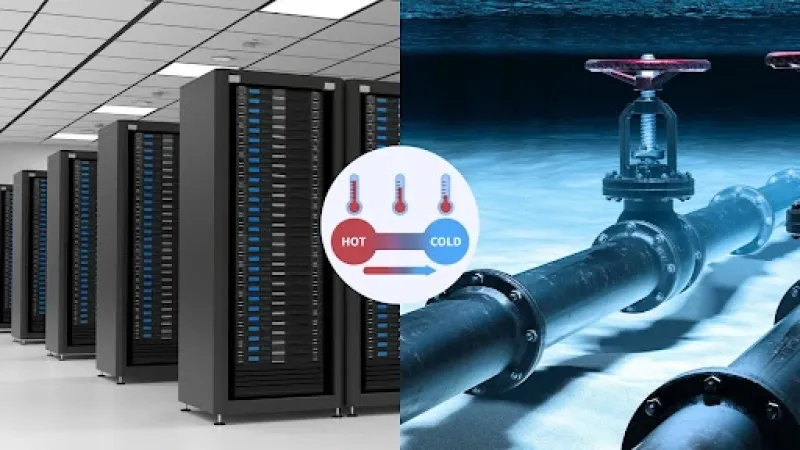
The world's insatiable appetite for digital services, from streaming movies to e-commerce, is fueling an unprecedented surge in demand for data centres. These digital powerhouses, essential for our connected lives, are also becoming massive energy consumers. According to the International Energy Agency, data centres accounted for approximately 1-1.13% of global electricity consumption in 2022, a figure projected to rise significantly in the coming years. Cooling these server-packed facilities is a significant part of this energy burden, often consuming up to 40% of a data centre's total energy use. This demand is expected to more than double by 2030, primarily driven by the expansion of Artificial Intelligence. As the planet warms and our digital footprint expands, finding energy-efficient and sustainable cooling solutions is a critical necessity.
In a new study, researchers from the Indian Institute of Technology (IIT) Bombay, under the guidance of Prof Gurubalan Annadurai, have unveiled a comprehensive methodology to assess the feasibility of Deep Seawater Cooling (DSWC) systems, presenting an alternative to conventional, energy-intensive cooling methods.
“In deep seawater cooling (DSWC) systems, cold water from deep ocean layers is transported through long pipelines to land-based facilities,” explains Dr. Kashish Kumar, a post-doctoral fellow at IIT Bombay and the lead author of the study.
The new study presents a framework that enables the precise calculation of the resources required and the payback period on the investments while implementing a DSWC system based on the prescribed methodology.
While the depths of the ocean offer an easy solution to our cooling needs, transporting large amounts of water over long distances, while maintaining its temperature and rate of flow, can be cost-intensive to both install and operate.
“As the cold water travels through warmer upper ocean layers, it can absorb heat and become less effective for cooling. Each segment (of pipeline) is also exposed to harsh marine conditions, including salinity, high pressure, and biological activity (biofouling),” explains Dr. Kumar about the challenges of using DSWC.
To analyse the feasibility of DSWC systems, the researchers developed an eleven-step methodology. First, they established the baseline by specifying a typical data centre's cooling load (100 MW) and typical operating temperatures, such as a server room temperature of 26-27°C and a supply air temperature of 22°C. They then estimated the power consumption of a conventional chiller-based cooling system, which relies on ambient air as a heat sink, taking into account monthly ambient temperature variations.
Can DSWC replace energy-guzzling cooling systems?
For a DSWC to be feasible, it would have to be as effective as the conventional cooling system, or more, while also being much cheaper to run. To compare, the team analysed the specifics of the DSWC system. They determined the required inlet seawater temperature (18°C) and the necessary mass flow rate (5972.3 kg/s) to meet the cooling demand. The location chosen for the prototype was the Sister Islands, part of the Andaman and Nicobar Islands, for its climatic and oceanographic advantages.
“In tropical oceanic regions, particularly around the equator and extending into low latitudes such as the Andaman and Nicobar Islands, seasonal variations in seawater temperature—especially at depths beyond 100 meters—are minimal. This consistent deep-sea temperature ensures that the DSWC system delivers reliable cooling performance throughout the year, without requiring seasonal modifications or recalibrations,” says Dr. Kumar.
A Thermocline profile of the region, which is a graph showing how seawater temperature changes with ocean depth, provided an accurate picture of the location of the cold water. They used data from the World Ocean Atlas for the specific location, the Sister Islands, to create the thermocline profile. This allowed them to pinpoint the exact depth of 2770 meters where the desired cold water could be found and how that temperature changed with elevation.
The team then utilised General Bathymetric Chart of the Oceans (GEBCO) data to identify the closest horizontal distance from the shore to this depth (2770 meters). This allowed them to calculate the actual pipeline length by accounting for the seabed's profile, and found it to be around 2784 meters.
For the pipeline itself, High-Density Polyethylene (HDPE) was chosen as the material due to its flexibility, lightweight nature, and resistance to corrosion and UV radiation. The optimal pipeline diameter was determined by balancing two critical factors: erosion velocity and deposition velocity.
“Erosion velocity refers to the maximum flow speed of seawater within the pipeline, beyond which the internal pipe walls risk being damaged by friction or particles in the seawater. Deposition velocity is the minimum flow speed required to prevent the accumulation of sediments or salt crystals,” explains Dr Kumar.
This analysis led to an optimal diameter range of 1.286m to 2.06m, with 1.45m identified as the most cost-effective. The thickness of the pipeline was also calculated to ensure it could withstand the external pressure of the deep sea without buckling.
To minimise heat gain as cold seawater travels from the deep ocean to the data centre, the researchers implemented a segmented insulation strategy. This divides the pipeline into sections, each with optimised insulation thickness. According to Dr Kumar, “Each segment receives insulation customised to its specific surrounding temperature. This approach ensures efficient insulation use, reduces heat gain, and optimises costs.”
Once these factors were calculated, the team could estimate the pump power consumption, a significant operational cost for DSWC, which measured the energy required to run the DSWC system. Finally, they could compare the energy consumption between DSWC and conventional systems.
Efficient cooling and environmentally friendly
Their findings show that when applied to a data centre with a 100 MW cooling load in a tropical region like the Andaman and Nicobar Islands, a DSWC system could achieve an impressive annual energy saving of 79%. Furthermore, the approach promises substantial environmental benefits, including over 79% annual reduction in carbon dioxide emissions.
More importantly, the framework boasts an astonishingly quick payback period. Assuming a cooling load of 100 MW, an average electricity rate of $0.0851 per kWh, and an operating time of 8760 hours/year, payback will take just eight months. This considers the maintenance cost to be 25% of capital cost annually and a discount rate of 6.75%, with significant investments being the pipeline itself, insulation, heat exchangers, and air ducting.
However, the researchers acknowledge certain limitations. Their study relies on some simplifying assumptions, such as fixed supply air temperature and heat exchanger performance based on standard guidelines, which might vary in real-world scenarios. The system also performs economically and operationally better in coastal regions with easy access to the deep ocean cold water. Further from the location of the cold water can increase installation and operational costs. Future research could benefit from more precise mapping of thermocline layers and seabed profiles, a deeper understanding of HDPE pipeline erosion velocities, and long-term studies on component degradation.
Nevertheless, the framework developed allows for investors to carefully assess the economic and technical feasibility of switching from conventional to DSWC systems. While the study emphasises data centre cooling, the standardised methodology is adaptable for various sectors, especially those with large, continuous cooling or heating demands. According to Dr Kumar, some potential beneficiaries could be “hospital complexes that require 24×7 cooling with minimal downtime, cooling for residential/commercial buildings in tropical coastal cities, Industrial Processing Units and Integrated Desalination and Cooling systems.”
By harnessing the naturally cold temperatures of the deep ocean, DSWC systems can alleviate strain on electrical grids, lower operational costs for businesses, and contribute substantially to reducing greenhouse gas emissions. By providing a clear, systematic methodology for DSWC implementation, this study paves the way for broader adoption of a cooling solution that is not only energy-efficient and economically viable but also crucial for building a more sustainable digital future.
“Developing nations may benefit immensely, particularly island nations and coastal regions. However, international cooperation, technology transfer, and targeted policy support (e.g., green finance or infrastructure subsidies) are essential for scalability,” concludes Dr Kumar.






